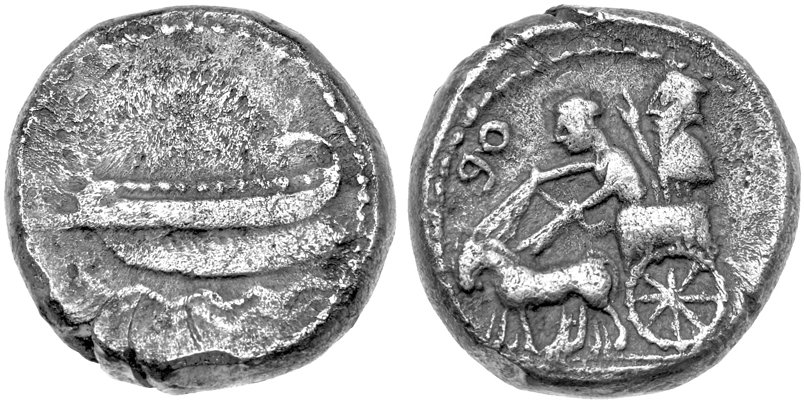Sidon (`Abd`aštart II), silver, half shekels (342-333 BCE)
From SILVER
342 BCE - 333 BCE Silver 22,235 kg
Description
| ObverseInscription or printing placed on the obverse.: | Phoenician war galley to left |
| ReverseInscription or printing placed on the reverse.: | Persian king in chariot left |
Mint and issuing power
| MintIdentifies the place of manufacture or issue of a numismatic object.: | Sidon | Ancient regionAncient region.: | Phoenicia | Modern countryModern country: Lebanon | AuthorityIdentifies the issuing power. The authority can be "pretended" when the name or the portrait of X is on the coin but he/she was not the issuing power. It can also be "uncertain" when there is no mention of X on the coin but he/she was the issuing power according to the historical sources: | Persian Empire, `Abd`aštart II, king of Sidon (342-333 BCE) |
Chronology
| FromIdentifies the initial date in a range assigned in a numismatic context. | 342 BCE | toIdentifies the final date in a range assigned in a numismatic context.. | 333 BCE | PeriodTime period of the numismatic object.: Classical 480-323 BC |
Physical description
| MetalThe physical material (usually metal) from which an object is made.: | Silver |
Median weightMedian of the weights of numismatic objects (in grams). in grams | 6.30 | DenominationTerm indicating the value of a numismatic object. Examples: tetradrachm, chalkous, denarius.: | half shekel | StandardStandard.: | Phoenician |
Image

S2001 Sidon Straton II half shekels.jpg [1]
References
| Die study referencePublication of the study: | Elayi - Elayi 20041Elayi - Elayi 2004, p. 287-288, n° 1911-1914 (Group IV.5.2) | ||
| Coin series referenceReference to coin series study: | Sear II2Sear II, n° 5945 | ||
| Coin series web referenceCoin series web references: | |||
Obverse dies distribution
| FrequencyFrequency of specimen in distribution. ᵖ | Number of obversesNumber of obverse dies. ᵖ (o) | % (o) | Number of coinsNumber of coins. (n) | % (n) | Die nameName(s) of the die(s). |
| 1 | 3 | 100 | 3 | 100 | 1, 2, 3 |
| Total | 3 of 3 | 100 | 3 of 3 | 100 |
Reverse dies distribution
no distribution is available
Quantification
| Number of obversesNumber of obverse dies. ᵖ (o) | 3 | Number of singletons (o1)The number of singleton coins. ᵖ | 3 |
| Number of reverse diesNumber of reverse dies. (r) | 2 | Number of coinsNumber of coins. (n) | 3 |
| Coins per obverse dieNumber of coins per obverse die. (n/o) | 1 | Coins per reverse dieNumber of coins per reverse die. (n/r) | 1.5 |
| Reverse per obverse ratioRatio of obverse dies divided by reverse dies. (r/o) | 0.67 | Percentage of singletons (o1)number of coins (n) divided by the number of singletons (o1) ᵖ | 100 % |
| Original number of dies (O) (Carter 1983 formula)The estimation of the number of coins according to Carter 1983 ᵖ | 176.47 | Coins struck if 20,000 as average productivity per dieCoins made if the average productivity for obverses (according to Carter) is 20,000. ᵖ | 3,529,400 |
| Original number of dies (O) (Esty 2011 formula)The estimation of the number of coins according to the singleton formula in Esty 2011 ᵖ (O) | Survival rate if 20,000 as average productivity per dieSurvival rate if average productivity is 20,000. ᵖ | 0.00000 | |
| Coverage (o = % of O) (Esty 1984 formula)Esty 1984 - coverage (% of O) ᵖ (o = % of O) | 0% | Die productivity if survival rate 1/2,000Average productivity if survival rate is 1/2,000. ᵖ | 34 |
| Weight of silver (in kg) if 20,000 coins per die (O = Carter formula)Carter 1983 * Median weight * 20000 (*10 if gold or electrum) ᵖ | 22,235 kg <br /> 22,235 kg | Die productivity if survival rate 1/5,000Average productivity if survival rate is 1/5,000. ᵖ | 85 |
Remarks
References
- ^ Elayi, Josette - Elayi, Alain G. (2004), Le monnayage de la cité phénicienne de Sidon à l'époque perse (Ve-IVe s. av. J.-C.), Transeuphratène Suppl. 11, Paris, Gabalda, 2 v., 855 p., 77 pl.
- ^ Sear, David R. (1979), Greek coins and their values. Vol. II, Asia and North Africa, London, xlviii, p. 317-762